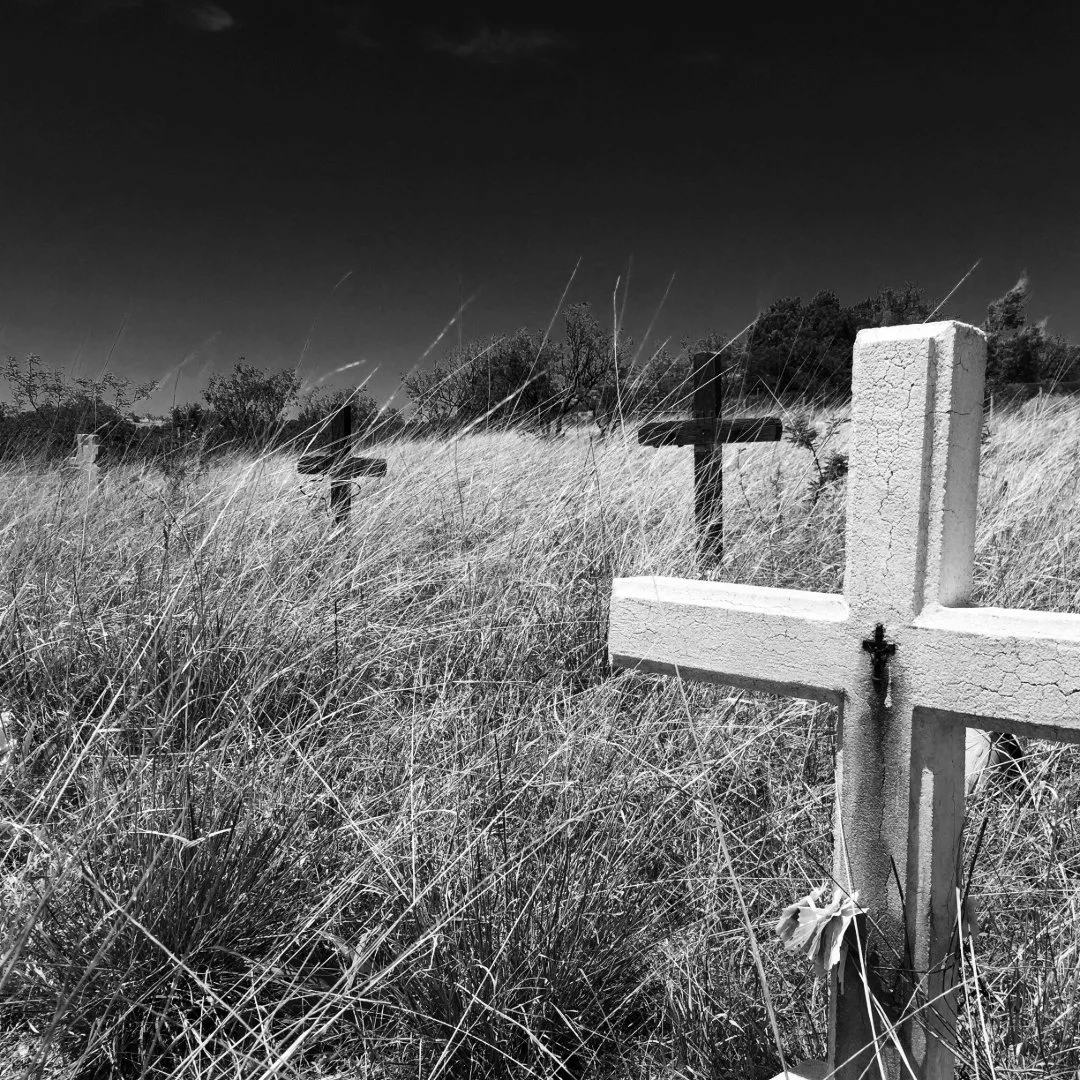Descansos: Roadside Memorials of the Southwest
Descansos: Roadside Memorials of the Southwest
Growing up, my family spent a lot of time on the road. We had a very Griswold-esque wood-paneled station wagon, multiple minivans, and sedans over the years. Our travels took us everywhere. Camping trips, visits to long-lost cousins who supposedly owned fish hatcheries, stops at every roadside attraction, monument, national park we could find, and aimless night drives with a spotlight that plugged into the cigarette lighter. We moved from place to place, but my personal favorite trips were the weekend drives in southern Arizona.
My dad had this old book on Ghost Towns of the Southwest that he lugged around. Rarely did we find the town we were searching for. Many of the places he wanted to explore were off the beaten path, and a ‘93 Chrysler Town & Country wasn’t built for those roads. We’d go as far as we could in the van, then continue on foot. I often wondered if we were even in the right place, his book was either left behind, or we’d be navigating from some scrap of paper where he had hastily transcribed directions. Looking back, I think we got close more often than we realized. Many times, we stumbled upon old cemeteries, their weathered wooden crosses standing just beyond the remnants of abandoned buildings. In hindsight, those graveyards were probably the ghost towns we were searching for.
Those overgrown fields of forgotten graves captivated me. I’ve always pondered the lives of those buried there, the stories they left behind. I believe most people share a quiet fascination with graves, a mixture of intrigue and unease. After discovering the first cemetery I can remember, the Greaterville, AZ Cemetery, I started to notice something else along the road: small, solitary crosses.
Greaterville Cemetery
We’ve all driven past them. Roadside memorials, simple or elaborate, marking the place where someone lost their life. For a fleeting moment, we acknowledge them. Some of us turn away, unwilling to dwell on the tragedy. Others briefly mourn a stranger or recall a terrible article they once read about the accident. They impact us in different ways, but they are always there, shaping the landscapes of our commutes and road trips.
Years ago, I had the incredible opportunity to work as an archaeological photographer in Greece. I was one of the few people on the dig with an international driver’s license and experience driving a stick shift, so I spent as much time behind the wheel as I did behind the lens. As we explored the Peloponnese, I noticed small structures along the roadsides. At first, they reminded me of tiny lending libraries, but their shape was unmistakably that of miniature Greek Orthodox churches. These were roadside memorials, known in Greece as Kandylakia.
There were a few near the site where we lived and worked, and more often than not, they bore signs of a motorcycle accident. Inside, family and friends had placed keepsakes, photos, candles, and offerings to honor the lives lost. Alongside Greece’s breathtaking landscapes, goat herds, ancient ruins, and the thrill of working on an excavation, these Kandylakia left a lasting impression on me.
Fast forward fourteen years, and my wife and I continue the tradition of road trips and exploration. Arizona’s highways and backroads are familiar to us, and along them, we see roadside memorials, some newly placed, others well-tended, and a few weathered by time. Sometimes we notice the fresh marks of a crash, the tire tracks and broken glass. Other times, we see a small group of people gathered at a memorial, leaving fresh flowers or lighting candles.
For years, I had talked about my deep curiosity and respect for these sites. Last year, Hayley encouraged me to finally start documenting them. On a trip from Flagstaff to Parker, she suggested we pull over when we had the chance. She would park as safely as possible, put on the hazards, and usually stay with Carlton while I walked back to the memorial. Wearing a high-visibility vest and setting up cones behind the car, I would step onto the roadside, camera in hand.
Each memorial carries a feeling. Some heavier than others. Some so strong that Hayley felt drawn to step out and join me. Among the roadside debris, shattered glass, discarded bottles, pieces of tires, there are tokens left behind. Layers of holiday decorations, some cracking in the desert sun, others freshly placed. Flowers in all stages of life: some wilting, some vibrant, some artificial. Food and drink offerings left in remembrance. Candles, wind chimes, solar lights, religious symbols, carved antlers, intricate metalwork. Names, dates, nicknames, Bible verses, heartfelt messages. And then there are the lonely ones, no longer visited, no longer adorned, just a quiet, nameless marker for someone lost.
We have tried to research the stories behind each memorial we photograph. Sometimes names and dates help. Sometimes a highway number or mile marker provides a lead. Other times, they remain anonymous, simply "Unknown Marker, AZ HWY 89." Through this research, we’ve learned that, like in Greece, many of these memorials mark motorcycle accidents. Many are the result of drunk or distracted driving. And tragically, some memorials mark violent crimes rather than accidents.
These memorials are more than roadside markers. Each one is a story, a life lost and a reminder of the love and grief left behind. The people mourned here were someone’s child, parent, sibling, or friend. Their absence echoes in the lives of those who knew them and in the roads we travel every day.
Through Descanso: Roadside Memorials of the Southwest, we hope to honor these lives, bring awareness to the dangers of the road, and remind us all to drive with care, not just for ourselves, but for the strangers we pass, some of whom never made it home.

